|
Cover
Story
Ahsania Cancer Hospital and Detection Centre
IMRAN H. KHAN
AND
SRABONTI NARMEEN ALI
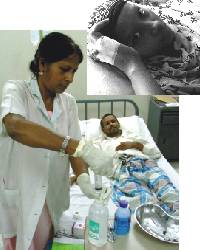 Living with cancer is not an easy feat for anyone. It is even harder when there is no treatment either available or affordable for the patient. In Bangladesh thousands of people are afflicted by this deadly disease and the majority of them are unable to get proper treatment. Until recently most of our hospitals were not able to offer sufficient and adequate doctors, facilities or equipment. The Ahsania Mission has taken a vow to change this. In 2001 it established a Cancer Detection Centre, a forerunner for the Ahsania Mission Cancer Hospital that it is building in Uttara. The idea is simple -- provide international standard treatment for cancer patients all over Bangladesh. Patients will be charged according to how much they can afford and for patients who are unable to pay, one-fourth of the facilities and treatment will be free of cost. In order to be able to provide this unique service, however, the Ahsania Mission has to raise a total sum of Tk. 150 crores. They are now appealing not only to corporations and companies, but also individuals and communities for their help in raising enough money to combat cancer in Bangladesh.
Shanaz, a thirty-three-year old woman, has been diagnosed with cancer in her left breast. In March this year, she went to a local hospital for treatment, where she underwent Chemotherapy as well as Radiotherapy. The treatment seemed to be working at first but then the doctors discovered that the cancer cells had not all gone. The cancer soon spread to her right breast. Three months ago she went to the Ahsania Cancer Detection Centre where she is currently undergoing treatment. Shahnaz is now on Chemotherapy, which consists of being injected with Taxotere -- one of the most expensive medicines available in the market. It contains the active ingredient docetaxel, an anti-cancer medicine known as a 'taxane'. Cancer forms when some cells within the body multiply uncontrollably and abnormally. These cells then spread and destroy nearby tissues. Docetaxel works by preventing the cancer cells from dividing and multiplying. This kills the cancer cells and stops the cancer from growing. Each dose of this medicine needs to be administered to Shanaz every three weeks and it costs about Tk.60,000.
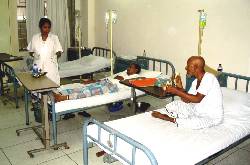 |
| So far, the Detection Centre offers about 50 beds. The main hospital, however, aims to have 500 beds |
Before being diagnosed with cancer, Shahnaz had passed her B.A. and was married. Unfortunately after she was diagnosed with cancer her marriage ended. Her father is a retired worker in Bangladesh Forest Department, now working in a private firm which helps to cover some of the expenses of treatment. But the treatment is still too costly for them and all they can do is hope for a miracle.
Hope is one thing that is not always prevalent when one is diagnosed with cancer. It is a deadly disease which often cannot be treated. For cancer patients in Bangladesh hope is even slimmer. Only a minority of the population can afford to go abroad for treatment. What then, becomes of the remainder of the population -- those of the lower-income and middle-income bracket who have to make do with the facilities and the services that they find in Bangladesh? About 1,000,000 people are affected by cancer in this country and this number increases a staggering 200,000 every year. Out of these cancer patients 150,000 die annually. Medical care -- specifically cancer treatment -- is at its best, mediocre in Bangladesh. Misdiagnosis and maltreatment are common. Add to that a lack of training, lack of advanced technology and facilities, lack of organisation, and a general disregard for anyone who cannot afford a better option. Current cancer treatment facilities of both the private and public sector can only accommodate 15,000 of these patients.
It was with these hard facts and figures in mind that the Dhaka Ahsania Mission decided to embark upon a new journey, one that would change the field of cancer treatment in Bangladesh forever. The concept of the Dhaka Ahsania Mission Cancer and General Hospital proposed to be built in Uttara, materialised in 2001.
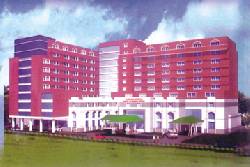 |
The model for the Ahsania Mission Cancer Hospital, to be built in Uttara. |
The Cancer Detection Centre in Mirpur is a precursor to the Cancer Hospital. It is a five-storey building with a total floor space of 30,000 square feet. While the Detection Centre has been operating successfully, providing testing and some treatment to patients, its facilities are far from adequate to meet the requirements of the growing number of people with cancer.
"If we can detect the cancer earlier, then the treatment process is much cheaper and faster," says Prof. Dr. Md. Abdul Hai, Director of Ahsania Mission Cancer Hospital. The Mission took a very bold step towards early detection and cure of this fatal disease when it founded the Cancer Detection Centre in August 2001. The detection centre diagnoses which kind of cancer it is and refers patients to the proper treatment in hospitals. It also carries out primary prevention activities.
"The Detection Centre basically serves as a preliminary screening process for patients," says Kazi Rafiqul Alam, Executive Director and President, Ahsania Mission. "It is there that patients will be diagnosed after which they can go to the hospital for further treatment. We chose a place like Mirpur because more than two million people live in that area, and I think the location is ideal."
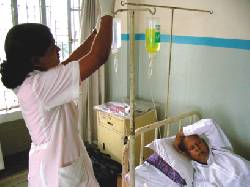 |
| Although the cost of treatment is very low at the Centre, patients still have to bear the cost of medication. |
The Detection Centre has about 50 beds and is complete with a daycare Chemotherapy unit, diagnostic laboratory, imaging facilities and two operating theatres, one of which is equipped with the latest machines and operating facilities. A group of top cancer specialists are also available around the clock and are continuously providing essential logistical support, diagnosis and treatment to the cancer patients.
"We want to open up some more early detection centres in the six main divisions of the country," Hai added, quite aware of the grim cancer scenario in Bangladesh. The mission of these detection centres will be the same as the one existing in Dhaka. Until today, close to 3870 patients have been registered at the centre. "We have more repeat patients than new entrants," says Hai. Excluding some senior doctors, there are currently eight junior doctors and six consultants at the Cancer Detection Centre.
The objectives of any Cancer Detection Centres are to, first of all, undertake investigations for the early detection of cancer and then treat the patients who have been tested positive for the disease. The main problem is to build awareness about cancer and also its prevention. Take for example smoking, which is the main cause for lung and throat cancer. The majority of rural people as well as working class people are still unaware of this cause and effect.
 |
Dr. Md. Abdul Hai, Director of Ahsania Mission Cancer Hospital. |
At the Detection Centre the patient is first registered after which lab technicians carry tests in order to determine whether the symptoms are related to cancer or not. If the tests are positive, further tests are taken to investigate the nature of the cancer. There are mainly three forms of tests done at the Cancer Detection Centre. The first test is called a Biopsy, where a part of a tumour, suspected as malignant, is sliced off and then tested for cancer cells. If cancerous cells are detected, the patients are treated accordingly. The second form of test is called FNAC, which stands for Fine Needle Aspiration Cytology. This is another effective and commonly used method where a fine needle is inserted into a tumour and the fluid sample is taken for tests. The PAP test is the third form of test, named after its developer, Dr. George N. Papanicolaou. PAP is the abbreviated form of Papanicolaou test and is an extremely cost-effective and beneficial test. A spatula is used to scrape off some sample from the tumour or affected area and is tested under a microscope.
The Ahsania Mission Cancer Detection Centre uses a wide array of treatment and detection methods starting from surgery to Chemotherapy, X-ray, Mammography and Ultrasonography.
Most cancer treatment options, such as breast cancer, will involve some form of surgery. If the cancer is in the form of a tumour then surgery can be carried out immediately but if there is a fear of it spreading to other regions, it needs to be constrained first.
An X-ray is another weapon doctors commonly use against cancer. In low doses, X-rays are used for making images that help to diagnose disease and in high doses, it helps to treat cancer. A Mammogram, is a special instrument that takes an X-ray of the breast and is the best tool for identifying breast cancer in its earliest stages. Mammography produces a black and white image of the breast tissue on a large sheet of film, which is "read" or interpreted by a radiologist.
 |
| Though the Detection Centre is well equipped with cancer detection facilities and treatment such as Chemotherapy, X-rays, Mammography, and Ultrasonography, it lacks certain vital equipment such as machines needed for Radiotherapy, due to a shortage of funds. |
Chemotherapy is a systemic therapy, i.e., it affects the whole body by going through the bloodstream. The purpose of Chemotherapy and other systemic treatments is to get rid of any cancer cells that may have spread from where the cancer started to another part of the body. Chemotherapy is effective against cancer cells because the drugs interfere with rapidly dividing cells. The side effects of chemotherapy come about because cancer cells aren't the only rapidly dividing cells in your body. The cells in your blood, mouth, intestinal tract, nose, nails and hair are also undergoing constant, rapid division. This means that the Chemotherapy is going to affect them as well. Still, Chemotherapy is much easier to tolerate today than before due to medical advancements. It is important to remember that organs in which the cells do not divide rapidly, such as the liver and kidneys, are rarely affected by Chemotherapy. In such cases, another form of therapy called Radiotherapy is used.
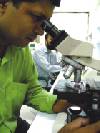 Radiotherapy involves the use of ionising radiation to damage actively dividing cells. Since cancerous cells are dividing more rapidly than most healthy tissues, cancerous cells tend to be killed first. However, the treatment is not specific. Radiotherapy can be used as a primary therapy in cases of inoperable diseases or when the patient refuses or is unsuitable for surgery. Preoperative (neoadjuvant) radiotherapy may be given to patients with highly malignant, localised tumours and to those with large tumours of lower malignancy, in order to shrink the tumor and facilitate surgical removal. Currently the Ahsania Mission Cancer Detection Centre does not have a Radiotherapy unit but it will be available in the Ahsania Mission Cancer Hospital, which will supposedly be the best-equipped cancer treatment hospital in Bangladesh. Radiotherapy involves the use of ionising radiation to damage actively dividing cells. Since cancerous cells are dividing more rapidly than most healthy tissues, cancerous cells tend to be killed first. However, the treatment is not specific. Radiotherapy can be used as a primary therapy in cases of inoperable diseases or when the patient refuses or is unsuitable for surgery. Preoperative (neoadjuvant) radiotherapy may be given to patients with highly malignant, localised tumours and to those with large tumours of lower malignancy, in order to shrink the tumor and facilitate surgical removal. Currently the Ahsania Mission Cancer Detection Centre does not have a Radiotherapy unit but it will be available in the Ahsania Mission Cancer Hospital, which will supposedly be the best-equipped cancer treatment hospital in Bangladesh.
One problem commonly associated with Radiotherapy is that a special room is necessary to store the machines, a room where there will be constant emission of radiation. The Atomic Energy Commission of Bangladesh is responsible for monitoring the radiation levels in these and other instruments. They monitor the radiation level to the surroundings as well as to the workers in the hospital and give a license for the use of such instruments. License for x-ray machines too must be obtained from the Atomic Energy Commission.
The Detection Centre currently has a 500 ma X-ray machine which is extremely useful for detecting lung cancer. They also have a powerful mammography machine, donated by Barrister Rafiq-ul-Haque, costing about Tk.29 lakh. He also makes a monthly donation of Tk.10,000 every month which helps to treat those patients who are unable to bear the high cost of cancer treatment. Besides him there are many others who contribute to making sure that the day to day operations of the Centre run smoothly.
 "Cancer does not affect only one specific part of the body," says Hai. "Starting from a person's skin, cancerous cells can form in a person's bone therefore leaving every part of a person's body vulnerable to this disease. To be able to cope with this, we require a hospital equipped with all the facilities for treating patients suffering from any kind of cancer." "Cancer does not affect only one specific part of the body," says Hai. "Starting from a person's skin, cancerous cells can form in a person's bone therefore leaving every part of a person's body vulnerable to this disease. To be able to cope with this, we require a hospital equipped with all the facilities for treating patients suffering from any kind of cancer."
As cancer is a very expensive illness, most hospitals do not come forward to invest in this sector. They feel that the costs will be too high to maintain in the long run. Why do people go out for treatment? It is mainly because they put their trust into the hands of foreign specialists. But there are a lot of cases where a patient goes for one treatment but the doctor administers another. "There was one case where a patient had gone to India for treatment," says Hai. "He said he had a bad chest problem and after being examined, he was diagnosed with TB. He received his treatment and all seemed well but soon after, more complications started to arise, and he came to this centre. Immediately, he was detected with lung cancer and we treated him accordingly. He is now fully cured."
"I think a lot depends on where one goes for treatment," continues Hai. Instead of where one goes to for therapy, it mainly depends on whom the patient goes for treatment. Everything depends on properly detecting of the problem and then solving it.
"What we wanted to do was promote international standard cancer treatment in Bangladesh," says Alam. "We are depending a lot on donor support, so we will start small and then gradually build it up from there. We want to benefit people living in the grass-root levels. It's very important that people who cannot afford treatment in countries such as India and Singapore will be able to get state-of-the art treatment right here in Bangladesh."
The Ahsania Mission Cancer Hospital will have different departments which focus on specific types of cancer in addition to providing the complete medical package for cancer patients including resources such as surgical oncology, medical oncology, radiology, laboratory medicine, primary and specialty care clinics, as well as Radiation therapy, Chemotherapy and a post anesthesia care unit.
When cancer is detected in the lungs, the cooperation of the cardiology department is vital to make sure that the cancer does not spread further. Likewise, for any region of the body, a different department is necessary where a specialist will ensure that the proper and effective treatment is administered. For the proper treatment of cancer, a multi-disciplinary approach is a must.
"By a multi-disciplinary approach, we mean that a team or a board must be formed for each patient so that each and every phase of the treatment can be discussed and planned," says Hai. "The medical team will map the whole process, thus improving the possibility of treatment." The hospital will also need different departments so that they can investigate, and in that way, make absolutely certain that the patient who is supposed to undergo, say the Chemotherapy treatment, will be able to stand the treatment.
The Dhaka Ahsania Mission was established in 1958 by Khan Bahadur Ahsanullah. Through the years the Ahsania Mission has aimed to work with and for the community in order better the problems faced by our society, such as education and skill development; employment and income generation support; water and sanitation; rights and social justice; health care; food and nutrition; drug abuse and prevention control. The Ahsania Mission has about 8000 gono kendro (public service centres) all over Bangladesh, which are instrumental in educating people. These centres are dedicated to spread knowledge of various health-related issues by holding lectures and practical sessions. Also through these centres, Ahsania tries to spread general awareness among the public about their general well being. Recently the Ahsania Mission has embarked on another project mention-worthy -- that of its Cancer Hospital and Detection Centre.
|
Patients of the cancer hospital will be charged according to how much they can afford. For poor patients about 25% to 30% percent of the services will be free of cost. This will be subsidised by zakat and voluntary contribution to the poor. The hospital will be built in phases, Phase One being the completion if 150 beds, Phase Two raising the number of beds to 350 and and the last phase with a total of 500 beds.
Apart from all these facilities and services the Ahsania Mission plans to offer one other service -- one that many medical institutes neglect -- support services for patients and their family members and loved ones. These services include pain management, counselling, information about cancer support groups, clinical dietetics, hospice and home care information and prosthesis. Counselling will be offered especially during the most difficult time for patients and their families -- the first few months after the treatment.
The proposed budget for the Ahsania Mission Cancer and General Hospital is Tk. 150 crore. The Ahsania Mission is working hard to raise funds in order to finish these projects.Recently the government of Bangladesh has passed a legislation whereby all the donations made in the name of Ahsania Mission Cancer Hospital will be exempted from tax. This will encourage people to donate which is a very good sign for the hospital.
"We are relying on the government's support as well as donor responses," says Alam. "Although we have not received much response from the donor community so far, we are hopeful that such a project will interest not only corporations but also the local community to donate and raise funds. In return for their donations, depending on how much they contribute, they will be able to name rooms and wards after their loved ones or themselves. Our idea is to encourage the local public to have a sense of partnership and feel that they are contributing to the greater community as much as is possible for them."
Corporations such as Dutch Bangladesh Bank and Dhaka Bank have contributed to this cause, but the Ahsania Mission is still hoping that more people and corporations will extend their generosity.
"So far the response has not been as positive as we would have liked from the donor community, in terms of corporations," says Alam. "We have obviously received generous donations from a few companies, but not as many as we would have hoped for. However, we feel that the response of the local community was very strong and we will start small by finding ways to allow them to contribute in whichever way they can."
With the response of the local community in mind, the Ahsania Mission has also organised a way to raise funds by conducting a lottery through 30 commercial banks, in which participants have the chance of winning lakhs with a ticket costing only Tk. 10. Proceeds of the tickets will go to the Ahsania Cancer fund. They hope that this will raise a major portion of the funds required.
Delwar Hussain, Project Director of Ahsania Mission Cancer Hospital communicates his hope on this programme saying, "We have also been promised some equipment that will be donated from foreign donors once the main hospital has been completed. We also hope to get funding from foreign agencies and donors."
It is important to establish a medical institution in Bangladesh that provides standard treatment, especially for diseases as life-threatening as cancer. For the majority of the people in this nation, going abroad for proper treatment is not an option due to lack of funds. Many hospitals in Bangladesh also offer treatment that is unaffordable for people in the middle-income and lower-income brackets. It is therefore important to support the Ahsania Mission's brave and noble cause in whatever way possible. The Detection Centre and Cancer Hospital aim to cater to people of all economical backgrounds with the best facilities and treatment possible, in the process proving that people with cancer can indeed have hope.
Copyright
(R) thedailystar.net 2005 |
